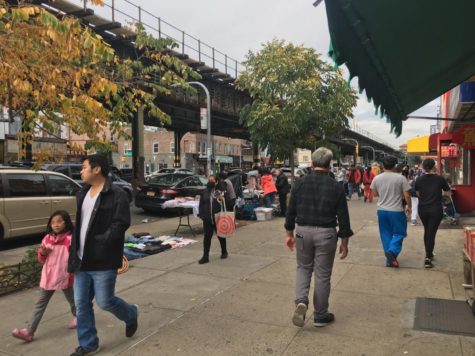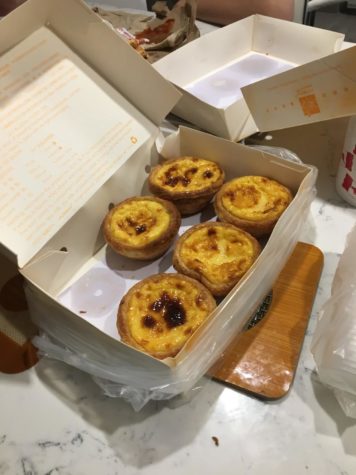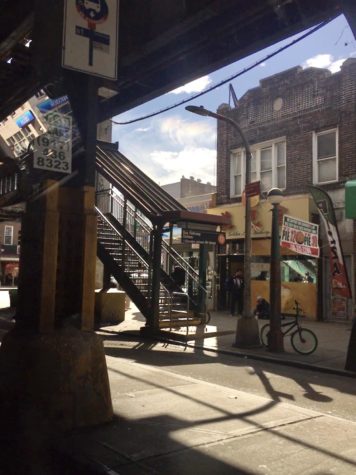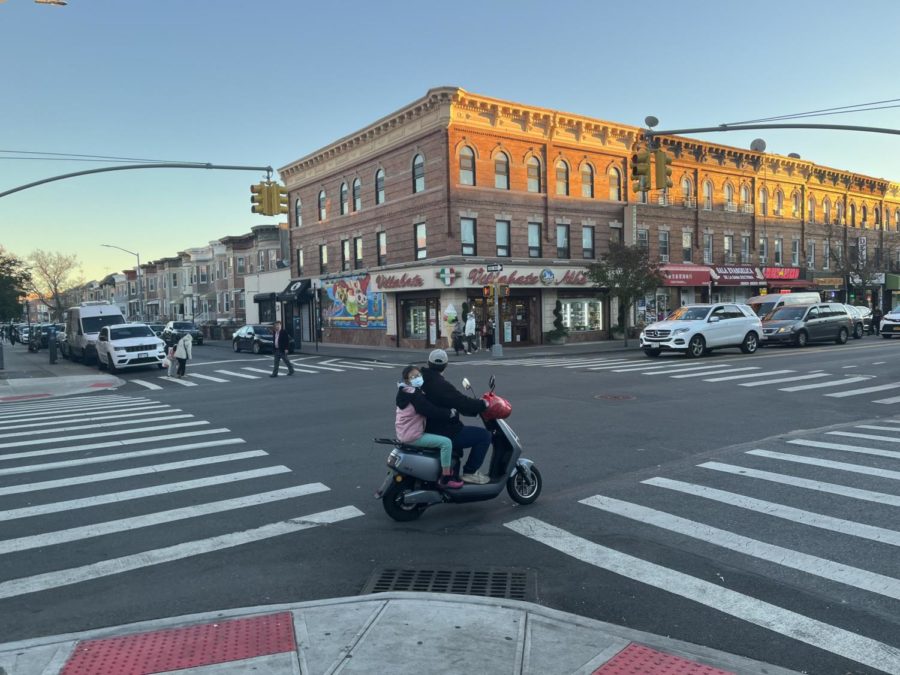A Trip to Brooklyn
The urban hustle and bustle of Brooklyn is unique from any other borough.
“We have history, culture, and Coney Island,” said Yana Burmich ’24, an avid Brooklynite.
It is a cool October morning in a quaint residential neighborhood tucked inside Queens.
The fresh-cut grass in our front yard shimmers in the sunlight. I walk around my backyard garden, looking at the cherry tomatoes and squash that have been growing. Depending on the hour, my sister and I might catch a glimpse of one of the neighborhood stray cats or a blue bird — there are not many pigeons here. Instead, we have mainly robins, blue jays, and sparrows. One of our neighbors might come outside – we know most of the residents on our block.
I take a breath of fresh air. There is no lingering scent of cigarette smoke — one of the things that I love about this neighborhood after living in Brooklyn for over a decade. When we first moved here just two years ago, we ordered our mattresses to be delivered over from Brooklyn. The store owner delivered the mattresses himself; he remarked on how fresh the air was compared to the muggy Brooklyn air.
I take one last glance at the suburban scene before my family and I drive off, cruising down Van Wyck and Belt Parkway until we reach Bay Parkway, Brooklyn – a 2.7 mile long boulevard in Bensonhurst.
My family typically goes grocery shopping in Elmhurst, because it is less expensive than grocery shopping in our neighborhood. But since we are in Brooklyn, my mother buys groceries on 86th Street, an Asian hotspot lined with various Asian stores shadowed by the D train tracks – there is some noticeable Hispanic influence in the region too. The Asian supermarkets are lined with displays of fruit, and crowds of Chinese men and women inspect the produce. Meanwhile, I wait in the car with my dad and my sister. There is no available parking, as usual, so we double park somewhere close.

After buying groceries, we drive down 86th Street to our go-to sushi restaurant: Sake Sushi. It’s an all-you-can-eat restaurant. We’ve been going to Sake for years now, and I can’t remember my family going to any other sushi spot in Brooklyn; we’ve been here with our grandma, ordered party trays for family gatherings, and sat at those tables for more times than I can remember.
It’s around noon, so the restaurant is quite busy. I help my mother write down her contact information on the yellow paper pad — they’ll call when a table is ready. We wait in the cramped hallway for a little while before opting to sit outside. Seeing the wide sidewalk lined with street vendors, I decided to explore 86th Street in the meantime.
My dad and I walk down the street, examining the street vendors’ merchandise laid out on tables or tarps on the ground. Looking back, our antics seem odd; I’ve lived in that neighborhood for over a decade, but until today, I never really gave them much attention. We see watches, small statues, coins from different countries, clothing, old items, and other gadgets. One man had a tarp strewn with what looked like old screwdrivers and pliers – my dad remarked that he would rather have thrown all that out. We come back from our short walk and continue waiting in front of Sake while I listen to a man bargaining with a street vendor. Finally, a table opens up and we go inside.
The restaurant looks practically unchanged after all these years; everything looks the same: the built-in shelves with their brick backsplash, the table arrangement, even the walls, which are white with burgundy bricks on the bottom half. The only difference is that some tables have now been reserved for holding takeout orders. We fill out the order sheets and wait for our food. My mom says that they used to include the price-per-person at the bottom of the sheet, but now they don’t even bother, since the prices have changed so much throughout the inflation rollercoaster. We order our usual dishes: avocado salad, miso soup, avocado rolls, eel rolls, and shrimp tempura. They mixed up our orders a few times, but we didn’t mind. A few bowls of avocado salad and several plates of sushi later, we ask for the check, pay, and leave.
My mother walks to Lily Bloom, a Chinese bakery, to buy a dozen egg tarts for our family gathering. Meanwhile, she sends me to another nearby traditional Chinese bakery to buy a bag of sponge cake. At the bakery, I ask for the price of the sponge cake and later say ‘thank you’ in Cantonese. I miss being able to confidently speak Cantonese in Chinese stores, knowing that the staff would understand me.

Chinese has two dialects: Cantonese and Mandarin. Mandarin is the official state language of China and the more common of the two. Many Cantonese speakers might learn Mandarin from Chinese school, but native Mandarin speakers usually do not know Cantonese. In Queens, Mandarin is more popular than Cantonese. For instance, Main Street in Flushing, Queens is known as an ‘Asian hotspot,’ but it is a bit disappointing having to speak English in Chinese stores, because I don’t speak Mandarin.
After the brief purchase, I wait outside of Lily Bloom for my mother. The streets are littered with trash and cigarette smoke fills the air, as elderly Chinese men take their smoke break outside. Cars honk and people walk to and fro, and occasionally the D train might pass by overhead. Brooklyn is by far the most populated borough in the city. Given this, it makes sense that the crowded streets of Brooklyn are filled with hustle and bustle; but to me, it’s more natural than the tourist façade of Manhattan. People go to Manhattan to experience what they think of as New York City, but Brooklyn is more authentic, industrial, and accessible than the grand streets of Manhattan. I do not have to prove myself in Brooklyn – Brooklynites could care less that you’re not from the area. Though the sparkle of Manhattan is exciting, it seems more distinguished and not as casual as Brooklyn.
“Brooklyn is my home,” said Allison Zhao ’24, a student at Stuyvesant High School. “I can take life at the pace I desire, and be able to see the skyscrapers across the body of water, rather than being among them and their busy streets.”
We visit our grandparents and extended family. Most of the houses in the area might have a small porch, lawn, or both — often with a patch of dirt or cement.
“Does Brooklyn have hills? No, it’s just cement,” said Yana Burmich ’24.
The typical front yards in Brooklyn are a stark contrast to the luscious green lawns that my neighbors in Queens pay hundreds of dollars for. I don’t hear any humming lawn mowers or see anyone outside tending to their flowers. It’s hard to find time to stop and smell the roses when one is rushing to get home early enough to find parking.
We spend time with our family for several hours and even stay for dinner, playing with our cousins while the adults chat. When the weather is nice, we might play outside, running around the cement covered driveway and backyard. My little cousins are used to the urban air of Brooklyn, so they always adore coming over to our house: biking up and down the suburban streets, rolling in the green grass like they do in the movies (yes they did that once), and even and especially, playing on the stairs.

Sometimes, before we leave, we might visit our former landlords, an elderly couple who we’ve known for years. We didn’t visit this time, but when we do, it usually goes like this: We arrive at our old residence on 18th Avenue, grateful to find nearby parking. My mom calls them in advance to let them know we’re coming. They were always very kind to us and are still family friends. When we arrive, they remark on how much my sister and I have grown and ask about school, business, and our garden. I stand there listening and chatting with them in Cantonese. The nostalgia blends into the blue sky. I still have memories of rollerblading down the street, pretending to run an ice cream store in the driveway, and perusing the busy streets and shops on 18th Avenue.
Another fond memory I have of Brooklyn happened during quarantine. When our avocados were nicely ripened, we would make guacamole; my mother would send me to buy tomatoes at the nearby market. It was a dazzling scene. The streets were dappled with the light of the setting sun, as I crossed the street and gazed at the several story buildings from afar, with everything wonderfully painted by the golden sun. The market was a short three minute walk away, but I cherished every second of the walk. I would buy two plum sized tomatoes, carefully inspecting them for defects. I had probably been to this market with my grandma before, but it was different entering the dimly lit store by myself. I embarked on this wonderful adventure twice; the second time I went, the lady at the cashier put the tomatoes in a paper bag. I carried that paper bag home past the deli, past the fish market, and past the large ice-cream statue outside of Villabate Alba, before turning to the block of attached multi-family houses.
However, as with all things on this earth, time has passed. A young woman now rents our old residence. The neighbors next door – an elderly man who used to call me ‘mei mei’ (little girl or sister in Mandarin) when I was younger – are trying to sell their house. Our former landlords have aged. I can see it in their frail skin, their hands, the glimmer of their eyes, and their hair. It makes me a bit melancholy to see them age. All my childhood, they were just our elderly landlords who lived downstairs. I am starting to comprehend their old age.
Despite the changes, some things still hold on. The corner 99-cent store is still there — it’s a neighborhood staple, I would say. The store owners might see us on one of our trips to Brooklyn, and they would still say hello. Villabate Alba is still a popular bakery among the Italian population in Bensonhurst. For all that I know, they are still the “best Italian bakery in NYC,” according to a Yelp review and still have long lines that run down the block on holidays. Many of the nearby stores are still familiar — besides that one bakery that keeps changing owners and store names, as well as several other stores that have also changed — and the neighborhood does not seem to have undergone rapid gentrification, but the signs of change are still present and real.
Upon moving to Queens, I have come to know the various neighborhoods, both residential and urban, that make up the borough: from Elmhurst (where I was born prior to moving to Brooklyn) to Oakland Gardens. Though I am certainly not an expert, surprisingly, I know far more about the neighborhoods of Queens than I do about Brooklyn.
But perhaps my regional knowledge was a survival tactic to become familiar with the new landmass and my fellow peers who live there. My parents prodded me to pay attention during our weekend car rides or to explore the map of Queens on my phone, so I would know more about Queens. I wanted to understand the neighborhoods, know their twists and turns, and know where that specific restaurant is.
During one of my first visits to our new house, I fervently snapped pictures of the nearest blue mailbox, the street signs, and a big, fancy house that served as a landmark, thinking that they would aid me in navigating the neighborhood – I rarely looked at them. It was likely my newfound zeal to become acquainted with this rich, unfamiliar borough that drove me to learn more and more about it.
Or maybe the quiet suburban neighborhood prompts us to explore the surrounding region in a way my family and I never felt the need to in the busy Brooklyn neighborhood I grew up in, where we had everything we needed in our community alone.
I can testify that I have met far more neighbors in my suburban neighborhood than I have in Brooklyn, simply by starting a conversation on the street. People in Brooklyn are far busier. Although there are usually more pedestrians on the street in Brooklyn, they tend to mind their own business. After living on that same street for over a decade, my family barely knew our neighbors living across the street. Now, in our current residence, we know almost all of the neighbors on our block.
Occasionally, I might spend time with a friend in Brooklyn, but it’s a rare occasion. When we do catch up, I don’t feel like a total stranger to Brooklyn. I still recognize the storefronts and some avenues. The grooves and ridges of Brooklyn are still somewhat ingrained. I feel comfortable, all the while knowing that I live in a drastically different neighborhood, have different friends, and have a different lifestyle than them. I can still call my middle school friend, who lives in Brooklyn, and we can pick right back up and chat. One time, I met up with her at Leif Erikson park – we used to go there after school when the weather was nice. We were watching a group of old, Asian men play volleyball (they were surprisingly very skilled). As we admired their sets and spikes, she said, “You should hang out with me and [another Brooklyn-friend].”
I had to remind her that I now live in Queens.
Another time, I asked my friend (who lives in Queens) to guess what borough I was raised in. She guessed Manhattan. Perhaps the urban culture of Brooklyn rubbed off on me and was translated as the big city. But let it be known, I am not from Manhattan. I am a Brooklynite who has simply retired into, and frankly grown to love, the quaint suburbs.
“We have history, culture, and Coney Island,” said Yana Burmich ’24, an avid Brooklynite.
Jacey Mok is an Editor-in-Chief for 'The Science Survey.' She loves the art of masterfully crafting a story and bringing the reader into the scene. She...











